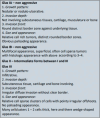Results of Mohs' Micrographic Surgery of Periocular Basal Cell Carcinoma: The Swedish Experience
- PMID: 38566404
- PMCID: PMC11000588
- DOI: 10.2340/actadv.v104.15765
Results of Mohs' Micrographic Surgery of Periocular Basal Cell Carcinoma: The Swedish Experience
Abstract
The Department of Ophthalmology, Sahlgrenska University Hospital, has until recently been the only eye clinic in the Nordic countries to perform Mohs' micrographic surgery of basal cell carcinoma. This has led to the practice of only the most complicated basal cell carcinomas being operated on with this technique. The purpose of this study was to present the results of these surgeries in patients with at least 5 years of follow-up. A retrospective study of all patients operated upon in 2010-2015 was performed. Data were gathered from their medical charts. Primary outcome was recurrence of basal cell carcinoma. One-hundred and sixty-seven patients were operated on. Mohs' micrographic surgery was used for tumours that were judged as highly aggressive on preoperative biopsy, had ill-defined borders, had recurred after previous surgery, or a combination of these factors. Nine recurrences (5.4% of all radical Mohs' micrographic surgeries) were diagnosed after a mean postoperative time of 37 months (4-84 months). Interestingly, all of these 9 recurrences after Mohs' micrographic surgery were in patients who had such surgery because of a recurrent basal cell carcinoma to start with. Good results can be achieved when operating on the most complicated periocular basal cell carcinomas with Mohs' micrographic surgery but special care has to be taken to ensure radical borders when operating on recurring basal cell carcinomas.
Conflict of interest statement
The authors have no conflicts of interest to declare. The last-listed author has had a minor commission for SantenPharma AB.
Figures



Similar articles
-
[Mohs' method of micrographic surgery as treatment for recurrent basal cell carcinoma].Ned Tijdschr Geneeskd. 1997 Mar 15;141(11):524-9. Ned Tijdschr Geneeskd. 1997. PMID: 9190509 Dutch.
-
Five-year results of Mohs' micrographic surgery for aggressive facial basal cell carcinoma in Sweden.Acta Derm Venereol. 1999 Sep;79(5):370-2. doi: 10.1080/000155599750010292. Acta Derm Venereol. 1999. PMID: 10494714
-
Mohs' micrographic surgery for basal cell carcinomas on the eyelids and medial canthal area. I. Characteristics of the tumours and details of the procedure.Acta Ophthalmol Scand. 2000 Aug;78(4):425-9. doi: 10.1034/j.1600-0420.2000.078004425.x. Acta Ophthalmol Scand. 2000. PMID: 10990045
-
Mohs' micrographic surgery for basal cell carcinoma.Clin Exp Dermatol. 1999 Mar;24(2):130-3. doi: 10.1046/j.1365-2230.1999.00433.x. Clin Exp Dermatol. 1999. PMID: 10233670 Review.
-
Peripheral in-continuity tissue examination: a modification of Mohs' micrographic surgery.Clin Plast Surg. 2004 Jan;31(1):1-4. doi: 10.1016/s0094-1298(03)00095-6. Clin Plast Surg. 2004. PMID: 15022789 Review.
References
-
- Gandhi SA, Kampp J. Skin cancer epidemiology, detection, and management. Med Clin North Am 2015; 99: 1323–1335. - PubMed
-
- Iorio ML, Ter Louw RP, Kauffman CL, Davison SP. Evidence-based medicine: facial skin malignancy. Plast Reconstr Surg 2013; 132: 1631–1643. - PubMed
-
- Moul DK, Chern PL, Shumaker PR, Zelac DE, Greenway HT. Mohs micrographic surgery for eyelid and periorbital skin cancer. Int Ophthalmol Clin 2009; 49: 111–127. - PubMed
-
- Saleh GM, Desai P, Collin JR, Ives A, Jones T, Hussain B. Incidence of eyelid basal cell carcinoma in England: 2000–2010. Br J Ophthalmol 2017; 101: 209–212. - PubMed
MeSH terms
LinkOut - more resources
Full Text Sources
Medical

